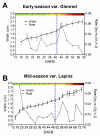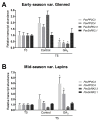Gibberellic Acid Modifies the Transcript Abundance of ABA Pathway Orthologs and Modulates Sweet Cherry (Prunus avium) Fruit Ripening in Early- and Mid-Season Varieties
- PMID: 33352825
- PMCID: PMC7767171
- DOI: 10.3390/plants9121796
Gibberellic Acid Modifies the Transcript Abundance of ABA Pathway Orthologs and Modulates Sweet Cherry (Prunus avium) Fruit Ripening in Early- and Mid-Season Varieties
Abstract
Several phytohormones modulate ripening in non-climacteric fruits, which is triggered by abscisic acid (ABA). Gibberellins (GAs) are present during the onset of ripening in sweet cherry fruits, and exogenous gibberellic acid (GA3) application delays ripening, though this effect is variety-dependent. Although an ABA accumulation delay has been reported following GA3 treatment, the mechanism by which GA modulates this process has not been investigated at the molecular level in sweet cherry. Therefore, the aim of this work is to analyze the effect of GA3 on the fruit ripening process and the transcript levels of ABA pathway orthologs in two varieties having different maturity time phenotypes. The early-season variety had a rapid transition from yellow to pink fruit color, whereas pink color initiation took longer in the mid-season variety. GA3 increased the proportion of lighter colored fruits at ripeness in both varieties, but it produced a delay in IAD-a ripening index-only in the mid-season variety. This delay was accompanied by an increased transcript abundance of PavPP2Cs, which are putative negative regulators of the ABA pathway. On the other hand, the early-season variety had increased expression of PavCYP707A2-a putative ABA catabolic gene-, and reduced transcript levels of PavPP2Cs and SnRK2s after the GA3 treatment. Together these results show that GA modulates fruit ripening, exerting its action in part by interacting with the ABA pathway in sweet cherry.
Keywords: GA3; IAD; abscisic acid; fruit tree management; gibberellin; non-climacteric; ripening; sweet cherry.
Conflict of interest statement
The authors declare no conflict of interest.
Figures





References
-
- Coombe B.G. The development of fleshy fruits. Annu. Rev. Plant Physiol. 1976;27:207–228. doi: 10.1146/annurev.pp.27.060176.001231. - DOI
Grants and funding
LinkOut - more resources
Full Text Sources

